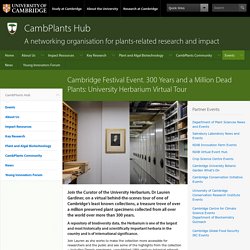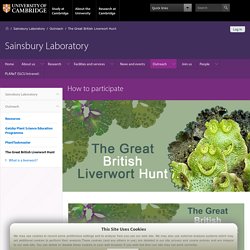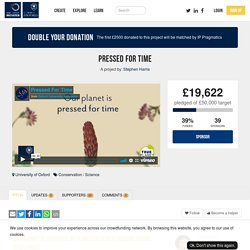

Cambridge Festival Event. 300 Years and a Million Dead Plants: University Herbarium Virtual Tour. Join the Curator of the University Herbarium, Dr Lauren Gardiner, on a virtual behind-the-scenes tour of one of Cambridge’s least known collections, a treasure trove of over a million preserved plant specimens collected from all over the world over more than 300 years.

A repository of biodiversity data, the Herbarium is one of the largest and most historically and scientifically important herbaria in the country and is of international significance. Join Lauren as she works to make the collection more accessible for researchers and the public and see some of the highlights from the collection – including Darwin specimens, unpublished 19th century botanical artwork, and material from the early 18th century. Please find registration information HERE. This event is part of the 2021 Cambridge Festival. Image: Inside the University Herbarium. How to participate — Sainsbury Laboratory. Thank you for your interest in The Great British Liverwort Hunt.

We have been overwhelmed by the positive responses and this activity is now fully booked! Please keep an eye on @slcuplants and this page for updates as to whether we can accommodate more participants in the future. In the meantime, we would like to encourage all plant enthusiasts to join our challenge and try to identify liverworts! Snap a picture and share them on Twitter with the #LiverwortHunt. Thinking of spring and looking forward to creating paper flowers with @KaperKate again tomorrow! Join us for some family-friendly papercraft #halfterm #familyfriendly.
The lab has adapted its science outreach activities. Hector Montero selected some confocal images from his recently finished PhD and printed them as 100 postcards. Using @postcrossing, they are being sent from Cambridge to random people, who will learn ho. Stonks. □□□ Color Our Collections. Color Our Collections Get your colored pencils ready!

Join us for the Color Our Collections event, February 4-8, 2019. Led by The New York Academy of Medicine, the event invites you to download images from library and cultural institution collections, color them, and share them on social media using the event hashtag #ColorOurCollections. With millions of natural history illustrations produced over 500 years in our collection, BHL is thrilled to participate in the event. How to Download Images from BHL for Color Our Collections. Coloring our pictures of the white ash tree from @MSU_Herbarium Kids loved searching for the right label! @JonesvilleCS #OneComet. Coloring Books - MSU Herbarium. Here are some beautiful colored-in pages from week 1 of the #MichiganTrees Coloring Book! Thanks to those who shared them with us! You can color-in this page too, go here to get it Next page this Saturday at 1 PM!
Herbaria: A Guide for Young People. Herbarium Creative Projects from Home » New York Botanical Garden. Sometimes we all just need to have a little fun.

What else do you see in these specimens—a house, a face, a unique creature? We challenge you to complete these specimens in your own creative way. “Animal” “Dress” “Creature” “House” Outdoor extension: Look carefully at the collection of plants growing in your lawn or the lawn or path edges of a park. Often, there are invasive plant species growing amongst the grass that are also quite beautiful. Position the plant parts on a piece of paper and the sandwich between heavy books. Jepson Herbarium. Cambridge University living plant collection available in database.
What's in a name? Our new #herbariumSnapshot looking at how the name given to a specimen name can change over time… PERSISTENT WAKEROBIN Trillium persistens LILIACEAE… Solanaceae - The Spooky Nightshades : Natural History Museum of Utah - Garrett Herbarium. Royal Botanic Garden Edinburgh. Created in collaboration with Kingdom Scotland, Scotland’s first fragrance house, Kingdom Botanica, is an evocative, botanical, and gender-inclusive perfume to mark the 350th anniversary of the Royal Botanic Garden Edinburgh.

Inspired by the enlightened spirit and dedication of botanists, horticulturists, scientists and plant hunters of the past, present and future, this extraordinary and bio-diverse perfume is expertly crafted by a classically trained Scottish perfumer, using only the finest sustainable and ethical aromatic ingredients. Biodiversity in a bottle Vibrant and passionate, this woody-green-floral oriental perfume draws inspiration from the herbaceous botanicals, spices and deep dramatic woods from some of the Royal Botanic Garden Edinburgh's key regions of work, in Asia, South America and the Middle East. Look at these professionals! Workshop invitation: After the crowds disperse: crowdsourced data rediscovered and researched. ***Deadline for expressions of interest extended to 30th October 17:00 UTC.

. *** Mindfulness Colouring Activities. Manchester Museum mindfulness colouring Activity At Manchester Museum we have worked with artist Lucy Burscough to take inspiration from our Botany collection to create these colouring sheets.

You don’t have to be an expert artist to colour! If you’re looking for an uplifting way to unwind after a stressful day, colouring will do the trick. Welcome to #PlantTaskmaster making a herbarium specimen with @Cambridge_Uni Herbarium @CUHerb curator Lauren Gardiner. Festival of Plants @CUBotanicGarden is online for the first time ever - day one (of three) today focuses on the @plantsci @CambPlants research @Cambridge_Uni. Here's a little video about the University Herbarium □□□□□□□□□□□□□□□□ #FoP20.
Having fun today with @NTBG Herbarium Curator (PTBG) Tim Flynn and Field Botanist Ken Wood demonstrating how to make a good specimen of a Pritchardia palm during todays Friday Science in the Garden talk about Herbaria and their many uses. #McBrydeGarden # Jepson Herbarium. N'est-il pas passionnant de redonner vie à ces estampes monochromes ? ✏️ Ces images de plantes présentent un intérêt tant scientifique qu’historique et artistique. Téléchargez l'ensemble des coloriages sur pour une version optimale ! #LeMuséumChezVous. "Recipe for a Perfect Specimen" Wondering how a specimen makes it into our collections? Want to make a specimen of your own? Here's how! #HerbAnimations #MSU #Herbarium #Animation #Collection.
On the week we should have been going to #RHSCardiff – join us in looking back at how we created the stained glass botanical windows for the show in 2017. #ThrowBackThursday. A Bouquet of Hope – Stories from the Museum Floor. This Easter, we are bringing together a collection of stories of some of the plants and flowers that are springing up in people’s gardens across the world. There are many flowers that have been used as symbols of joy, positivity and hope – definitely things that we could all do with right now… You can find out more about our flowers, plants and blossom on the curator’s blog. Roses for well-being and mindfulness Our environment can play a very important part when it comes to our mood, especially in a time like the present when it seems like things are out of our control. Sometimes when life throws things at us to keep a positive mindset is the most important thing, but the objects around us can be crucial too. Flowers and greenery have an impact on our health, reducing stress and promoting tranquillity.
Personally, when I am around flowers I tend to feel less anxious and depressed. Shaun Bennett Borage – A Star of Nature. We're currently reporting project progress to @HeritageFundUK and we're delighted to show how children from @LincsWildlife Far Ings @wildlifewatch Group are developing their own herbarium folder. Inspirational! □□□#ThanksToYou. The Hand Lens - The William & Lynda Steere Herbarium. Virtual Herbarium Expeditions @ NYBG - The William & Lynda Steere Herbarium. Narratives Details - The William & Lynda Steere Herbarium. By Rashad Bell, Nuala Caomhanach Feb 20 2020 In honor of Black History Month, Black Botany: The Nature of Black Experience seeks to acknowledge the complex relationship between enslaved Black people, nature, and the colonial environment and reconsider the conscious omission of Black knowledge of the natural world.

In relation to the legacy of the history of botanical science and colonial histories, the absence of the Black experience perpetuates the ongoing exclusion of Black people within modern society, by whitewashing a history where racism, science, and colonial power were inherently entwined. Many natural history collections held in museums of the western world have their origins in European colonialism. Their early specimens were often collected utilizing unacknowledged local labor, expertise, and knowledge; shipped to western scientific institutions on board merchant, slave, and trading mission ships. Oak Spring Garden Foundation - 8 Films Starring Plants. Discovery and the Dead Plants Society. Sainsbury Laboratory , 47 Bateman Street , CB2 1LR Comprising some 1.1 million preserved plant specimens, the Cambridge University Herbarium represents over more than 300 years of discovery, with specimens collected from all over the world.

Many of the 19th century plants were collected by some of the great Victorian scientists and explorers, including Henslow, Darwin, Wallace, Lindley, Douglas, and Spruce. Join Herbarium Curator, Dr Lauren Gardiner to find out about the treasures which are being discovered in this extraordinary collection, part of the Department of Plant Sciences, and why these specimens are so important today for scientific as well as historical research. The somewhat hidden entrance to the Sainsbury Lab is next to St Mary's School's Art Centre at 47 Bateman Street. The gravel driveway next to the building leads to main gates of Lab. The @LSUHerbarium Night at the Museum was a success we had fruits with @yeyoburneo, we had pollination with @L_DBall and @JanetMansaray , we had plant mounting, we had messy crafts! #LagoLab @LSU_MNS.
Wanna support student research in #botany AND get a cool T-shirt with native #MedicinalPlants of the SE USA? Look no further than the #Emory #Herbarium T-shirt fundraiser! All funds raised go directly towards student fieldwork & herbarium research! Or. Webinar: Broadening Participation to Juveniles in Detention and Those Recently Released.
Graeme Wotherspoonfrom @The_RHS talking how the #herbarium was used to fund raise - including these beautiful greetings cards being created. #NatSCAFunding @Nat_SCA @World_Museum… Student well being event for @UoM_EES Natural science students yesterday @McrMuseum #Students had the opportunity to draw botanical specimens up close. As well as therapeutic sorting of molluscs! @Aristolochia. Colonialism and Museums. Scaling up public engagement in botanical research - Mast - - American Journal of Botany. Stephen Harris is crowdfunding with OxReach. Unlocking the potential of plants to tackle pressing global challenges pressed for time Climate change and the effects of human activity on the planet have created a crisis in biodiversity and natural resources.

The legume family – the "peas and beans" – are vital for human well-being in communities around the world, providing food and fodder, fuel and fertiliser, and even pharmaceuticals. Legumes play an essential part in fixing nitrogen, improving soil fertility and water retention and reducing soil erosion - and are vital for researchers addressing key United Nations Sustainable Development Goals such as Zero Hunger, Good Health, Climate Action and Life on Land. Between 1877-1916 @kewgardens sent seeds, woods, fibres and other #plant materials to 670+ British & Irish schools comprising c. 18,000 specimens. Thanks to @Kew_LAA + @BioDivLibrary for digitising the 1st volume of school letters. Check it out! Carl Linnaeus DOTD in 1778. Linnaeus formalised the modern system of naming organisms - Binomial nomenclature, the two part naming system. The first part identifies the genus, while the second identifies the species. This image of Linnaeus made of specime.
We have an upcoming seminar by #Herbarium director @MossPlants & a workshop by staff coming up at the @knoxgarden!!! You can register for either of these through. Hookathon: hacking the Herbarium - Hackathon in London. For the first time, Kew Gardens are offering historical datasets and images relating to Joseph Hooker, inviting you to explore imaginative ways in which digital tools can be used to experiment with these sources and provide new ways of understanding this historical data. Sir Joseph Dalton Hooker (1817 – 1911) was a trailblazing botanist and explorer. Detailing plant diversity and economic botany throughout his many expeditions, he remains an influential figure to modern botanical science. The legacy of Hooker’s work can be seen throughout Kew: from the new plant specimens he introduced to Kew, as most notably seen within the Rhododendron Dell, to the dried specimens, museums objects, publications and illustrations which are housed within Kew Gardens.
Many parts of these valuable collections have been digitised by the respective departments in Kew which house these collections to improve access to these resources. Home - ONE TREE, ONE PLANET. Hookathon: hacking the Herbarium Tickets, Sat, Jan 25, 2020 at 10:00 AM. For the first time, Kew Gardens are offering historical datasets and images relating to Joseph Hooker, inviting you to explore imaginative ways in which digital tools can be used to experiment with these sources and provide new ways of understanding this historical data. Sir Joseph Dalton Hooker (1817 – 1911) was a trailblazing botanist and explorer. Detailing plant diversity and economic botany throughout his many expeditions, he remains an influential figure to modern botanical science.
The legacy of Hooker’s work can be seen throughout Kew: from the new plant specimens he introduced to Kew, as most notably seen within the Rhododendron Dell, to the dried specimens, museums objects, publications and illustrations which are housed within Kew Gardens. It was his exploration of the Himalayas and India, 1847-1851, which he is perhaps best known and one which would elevate his standing as not only a botanist but as one of Britain’s foremost scientists. Datasets will include:
The Hand Lens - The William & Lynda Steere Herbarium. Coloring Our Collections: The Art of Lithography. This year for Color Our Collections, we've produced a coloring book with illustrations from books that represent the evolution of the art of printing. This week on our blog, we'll explore the books featured in the coloring book and the printing techniques used for the illustrations. You can download our 2017 Color Our Collections coloring book here. Learn more about Color Our Collections here.
The Art of Lithography The process of lithography was first discovered by a German actor and playwright, Alois Senefelder, in 1796. In the lithographic process, the image is drawn onto a stone with a grease-based ink or crayon. Museum Mural Discovery Map. Scientific name: Datura stramonium Native Range: North America Garden Location: Due to the plants poisonous nature there are no specimens in the Garden's collection. Point of Interest: While jimsonweed weed has a lovely trumpet shaped blooms, all parts of the plant are poisonous. In 1676, British soldiers were sent to stop the Rebellion of Bacon. Jamestown weed (Jimsonweed) was boiled for inclusion in a salad, which the soldiers readily ate.
As told by Robert Beverly in The History and Present State of Virginia (1705): The soldiers presented "a very pleasant comedy, for they turned natural fools upon it for several days: one would blow up a feather in the air; another would dart straws at it with much fury; and another, stark naked, was sitting up in a corner like a monkey, grinning and making mows at them; a fourth would fondly kiss and paw his companions, and sneer in their faces with a countenance more antic than any in a Dutch droll..... Our latest #HerbariumSnapshot looks at how conifer specimens can be preserved #herbarium. #halloweencostume” Chrysler Herbarium: A Treasure Trove of Plants from the Past : Newsroom. Jepson Herbarium: Workshops. Introduction to Lichen Identification and Ecology.
Tree-mendous Trees! Children are making mini-herbarium sheets today in our Clore Natural History Centre @World_Museum & making leaf crowns with @Ness_Gardens Celebrating #NationalTreeWeek. The BRIT Herbarium discovered this fern specimen during a digitization project. These collections were made in 1875 by John Muir, founder of the @SierraClub and the father of the National Park System. #NationalParkSystem #Plant2Planet #JohnMuir #Botany #F. Delighted to note that these beautiful #flax specimens from @RBGE_Herbarium by Moray field botanist Mary McCallum all appear to be collected from rubbish dumps. Fall foliage prize wheel, and make a mini specimen.
Natural History Network. ASPB Partner, Wiki Edu, offers new handbook for writing species articles. The species guide is a great resource for current and future courses recruited through our American Society of Plant Biology partnership. These guides were drafted with help from various WikiProjects, experienced editors, and instructors, as well as our Wikipedia Content Expert in the Sciences, Ian Ramjohn. The species brochure was a wonderful collaborative effort with various WikiProjects and experienced Wikipedians SchreiberBike, Shyamal, Plantdrew, MontanaBW, ClemRutter, and Parkywiki.
Special thanks to Dr. Robert Macfarlane on rewilding our language of landscape. Eight years ago, in the coastal township of Shawbost on the Outer Hebridean island of Lewis, I was given an extraordinary document. Has Botany got its poster boy? - AoB Blog. At Plant Science Today Mary Williams is looking forward to the release of The Martian, a film that could have a major effect on the perception of botany. She notes that it has two major features, botanist as the hero – and the botanical work is a key element of the film.
Make Your Own Herbarium. Make Your Own Herbarium Identification Book. Australia: Greater engagement with the public and end users of taxonomy. Taxonomy is a field that celebrates the immense diversity of life and allows for effective communication across not only scientific disciplines related to biology, but also for a whole range of other fields and industries that are crucial to our society (e.g. medicine, biosecurity, horticulture etc.). How you can use online herbaria to learn about plants. Mnemonics an Effective Tool for Adults Learning Plant ID. The decline in interest in plants in biological education is an established phenomenon. Resources for botanists from BSBI. iDigBio delivers digital collections of natural specimens.
Navigating Nature, Culture and Education in Contemporary Botanic Gardens - Environment and Learning. Tiki figures Kula Botanic Garden, Maui HI If you are interested in environmental education or informal learning environments, such as botanic gardens, I invite you to read the essay Navigating Nature, Culture and Education in Contemporary Botanic Gardens in Environmental Education Research by Dawn L.
Reflecting on a year in outreach – Plant Fascination, STEM clubs, 3MT and IASUK. iDigBio and Storytelling Outreach Webinar. Herb Madness 2018. Seeing Plant Literacy Through Skyrim. Chaenactis carphoclinia (pebble pincushion) Come along to @TheBotanics this weekend & create a "Frankenstein" specimen with @RBGE_Herbarium team part of the @EdSciFest. This event is fun crafts, then digitise your creation (+ a touch of info about our specimens & herbaria) Suitable for all ages. So.
Natural History Museum. Come on in for a visit to the #herbarium if you’d like to warm up on your way to class! #HerbSign #collections @UTK_EEB @UTKnoxville. The ReCap: Stories from California Herbaria. A local art student's project reinvigorates this Polish tram stop with dried flowers. Nice to see the UC Herbarium CINC represented at UC’s special exhibit. Congrats to Eric Tepe & Amy Harmon for pulling the pieces together! @BiologyUC. (92) (PDF) Make your own Herbarium Specimens TABLE OF CONTENTS.
Introducing our new animated series "Inside Herbaria: Squint Harder" Stay tuned for more episodes that bring you closer to the nature around you! Animations by Benjamin Mitchell (@Ben1Mitch ) #HerbAnimations #Herbarium #MSU #MSUherbarium #animation #educa. Dipping into my "tours folder" this afternoon, nice to get some of my favourite thong weed specimens out - Himanthalia elongata - pressed by E. George. Those estranged #herbarium fragments can be good for something! We like to use them for #crafts and #outreach.